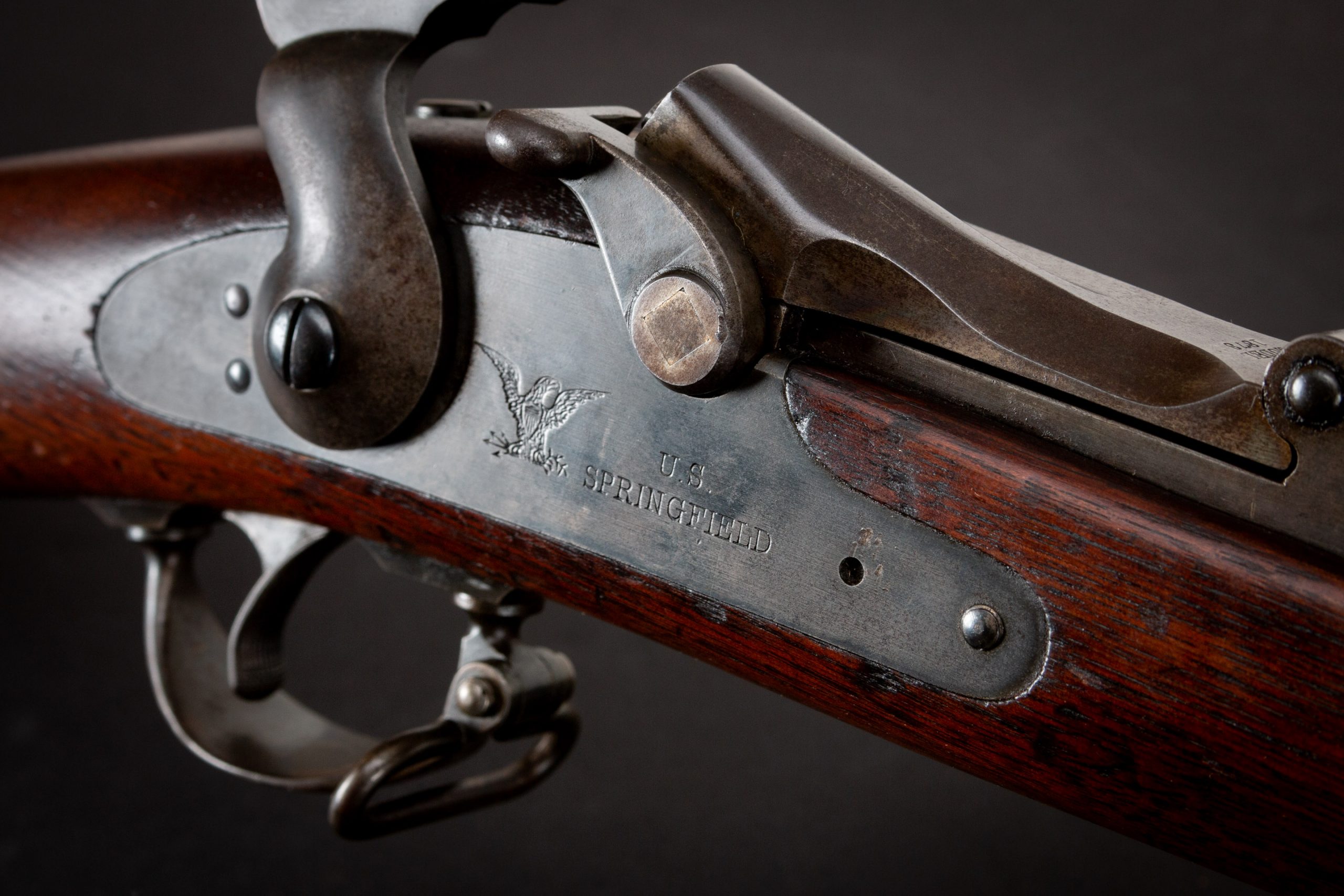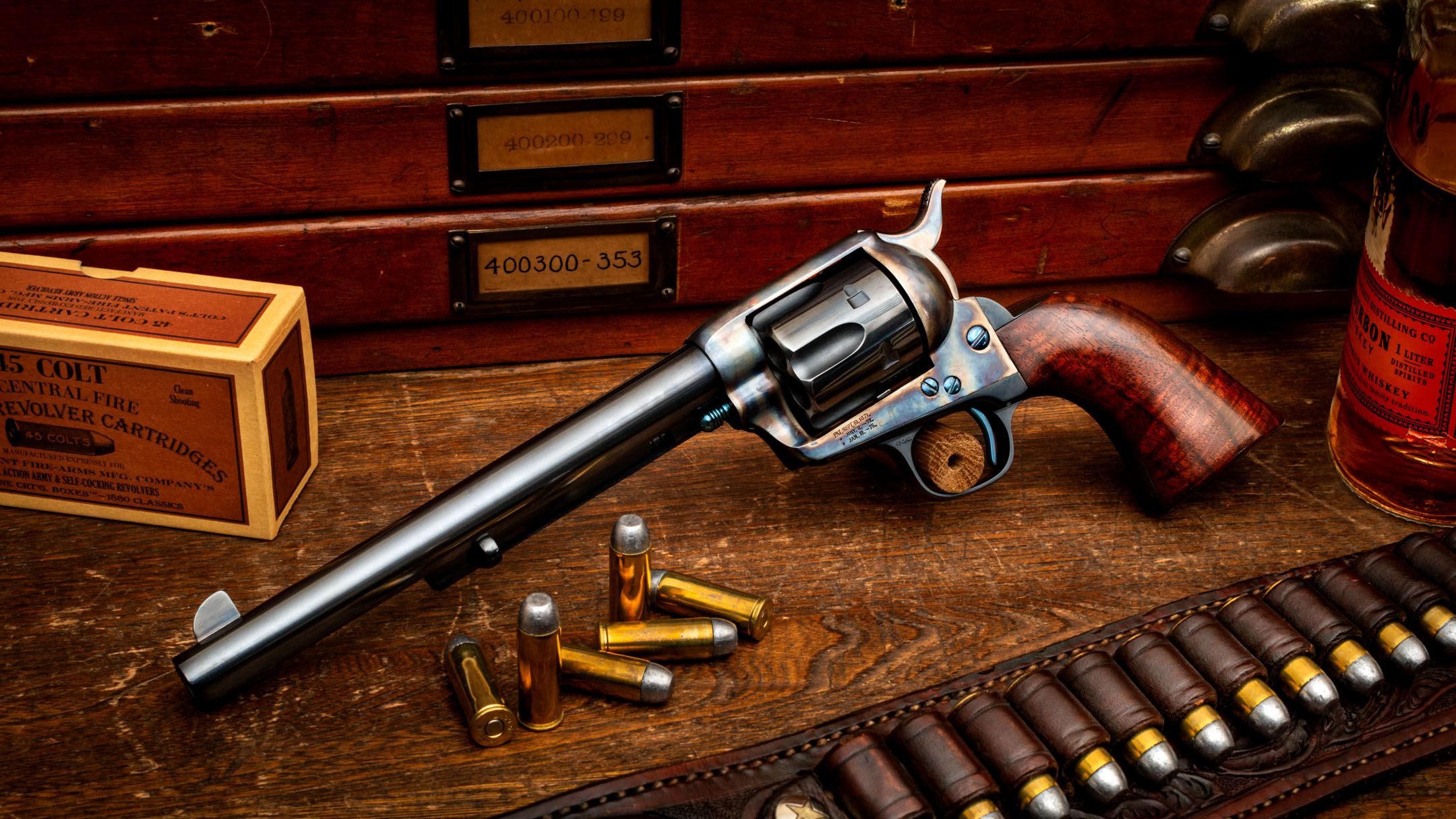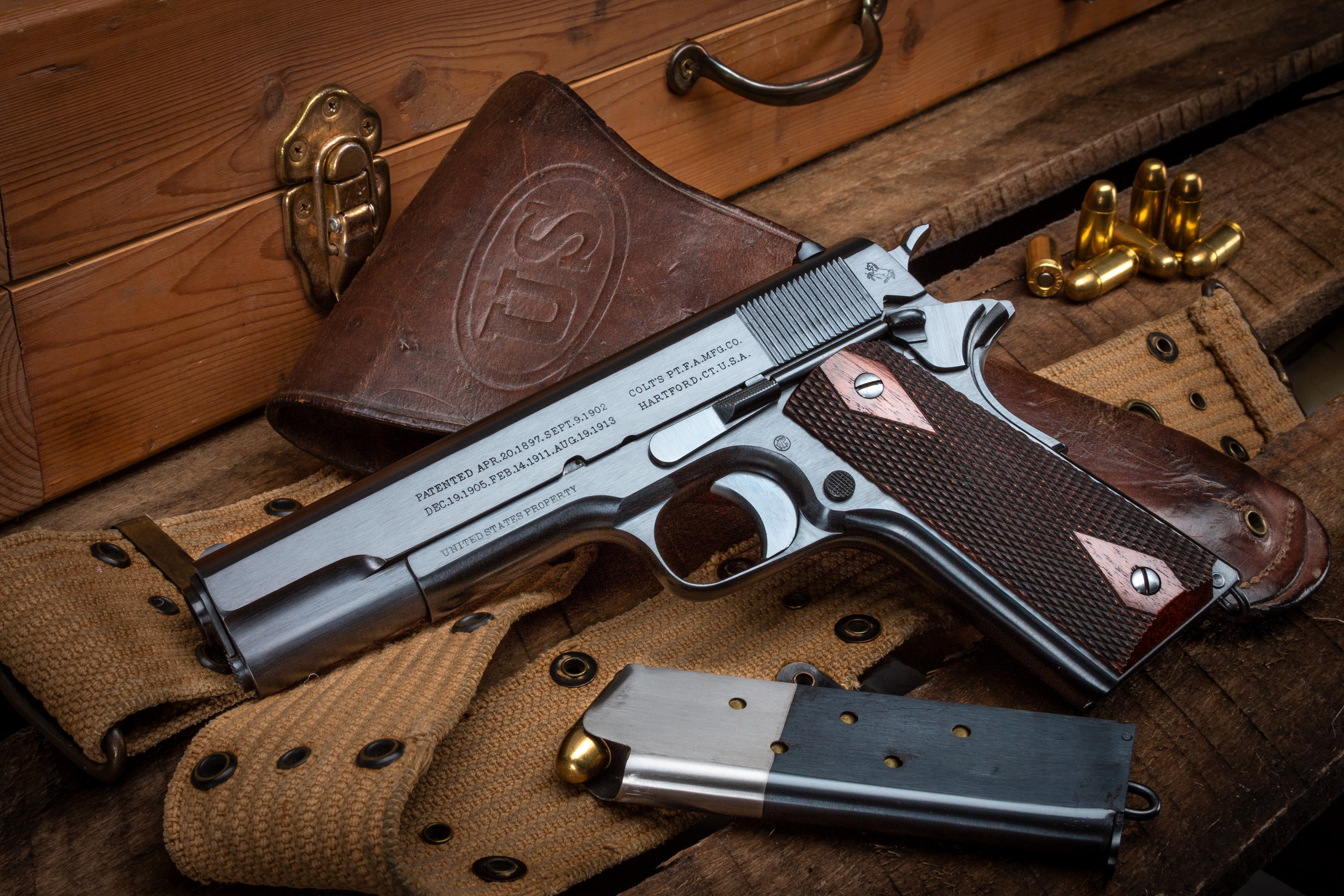While we remember the legacy, express our deepest gratitude, and pledge to uphold the values defended by our greatest heroes, we offer 10 of their most legendary service arms from the late 19th and early 20th centuries.
Which U.S. service arms are the most famous? Here are 10 early models to start the conversation.
The United States has a rich and enviable history of military firearms that have played a crucial role in the defense of our great nation and the values we uphold. These icons of American ingenuity and might have been used in countless battles and conflicts, and have become lasting symbols of American military history. In this article, we will explore some of the most famous American military firearms of the late 19th and early 20th centuries.
Please share your stories.
While you’re reading, we encourage you to think about and offer up any stories you may have. Are any of these American legends in your family? What do they mean to you? We’d love to know your stories, so please feel free to use the comment section below to share.

Image: Springfield Model 1861. Public domain. A note to collectors and preservationists: although the Model 1861 is not among the firearm makes/models that we restore, auction houses such as our friends at Rock Island Auction acquire examples for sale.
A Civil War Workhorse
The Springfield Model 1861 was the most widely used rifle by the Union Army during the American Civil War, favored for its range, accuracy, and reliability. This muzzle-loading rifle fired a .58 caliber Minié ball and represented a significant improvement over its predecessors. It offered a faster rate of fire and increased accuracy, which were crucial advantages on the battlefield.
Overwhelming Demand on the Battlefield
As the demand for rifles during the American Civil War grew, the Springfield Armory alone couldn’t meet the required production numbers. To address this, the United States government turned to private manufacturers to fulfill the contracts. The renowned Colt Manufacturing Company, known for its revolver production, played a significant role in producing the Model 1861. The collaboration between Colt and the government ensured a steady supply of rifles for Union troops. The contract also spawned improvements that would be included in later US military guns like the successor Springfield Model 1863.
A Collector’s Pride
Nowadays, the Springfield Model 1861 is a prized possession for collectors of Civil War guns, antique weapons and military memorabilia. It is considered one of the most significant firearms in American military history, with surviving examples often showcased in museums and private collections.
|| Back to table of contents. || Finding our article helpful? Enter your email address to receive updates. ||

Image: Springfield 1873 Trapdoor. A note to collectors and preservationists: although this is not among the firearm makes/models that we restore, we have acquired examples for sale in the past. Bookmark our showroom page and subscribe to our newsletter to stay up-to-date.
A Transition to Modernity
The Springfield Model 1873 Trapdoor marked a significant transition in American military rifles. This breech-loading single-shot rifle, equipped with a distinctive “trapdoor” mechanism for cartridge insertion and chambered in .45-70 Government, replaced the muzzle-loading Springfield Model 1861. The adoption of the Trapdoor design allowed for quicker reloading and improved efficiency on the battlefield, a crucial advancement during the late 19th century.
Service in Frontier Campaigns
Deployed in various frontier campaigns and conflicts, the Springfield Model 1873 Trapdoor proved its worth in engagements against Native American tribes and other adversaries. Its reliability, ease of use, and range made it a favored choice among soldiers facing the challenges of Western expansion and territorial disputes.
Symbol of American Innovation
The Springfield Model 1873 Trapdoor’s innovative design and adaptability reflected the ongoing evolution of American military firearms. Its presence in significant historical events, such as the American Indian Wars and the Spanish-American War, underscored its role as a symbol of American ingenuity and military prowess during a transformative period in the nation’s history.
|| Back to table of contents. || Finding our article helpful? Enter your email address to receive updates. ||

Image: Restored Colt Single Action Army (SAA) with early “Black Powder” frame. Explore additional SAA restorations here.
The Birth of the “Peacemaker”
The Colt Single Action Army (SAA), also known as the “Peacemaker,” is one of the most recognizable American firearms of all time. Introduced in 1873, it quickly became the preferred sidearm for cowboys, lawmen, and outlaws. The SAA was a single-action revolver that could hold six rounds of .45 caliber ammunition. Its simplicity, reliability, and accuracy made it a beloved tool in the American frontier.
The SAA in Military Service
Despite its association with the Wild West, the SAA was also a staple of US military weapons. It was used extensively in the American West, where it played a role in imposing law and order. The revolver saw action in numerous military conflicts, including the Spanish-American War and the Philippine-American War, proving its worth in various combat situations.
A Lasting Legacy
Even after over a century, the Colt Single Action Army is still in production, a testament to its enduring design and popularity. A number of notable gun makers and independent builders have adopted the single-action revolver platform as well, ensuring Peacemaker legend lives on. It remains a sought-after piece for shooters and collectors, symbolizing a seminal era of American history while continuing to influence modern firearms design.
|| Back to table of contents. || Finding our article helpful? Enter your email address to receive updates. ||

Image: Restored Winchester Model 1873 from 1882. Explore additional Winchester 73 restorations here.
Innovating Firearm Technology
The Winchester Model 1873, known as the “Gun that Won the West,” was a groundbreaking firearm that revolutionized rifle technology. As the first rifle manufactured by Winchester to utilize a centerfire cartridge, it was more reliable and accurate than the earlier Model 1866 (originally chambered for the rimfire .44 Henry). Its sleek design and smooth action made it a favorite for a wide range of users, from soldiers to civilians.
The Rifle of the Frontier
Winchester, among other commercial firms, manufactured their latest rifle in military trim with extended magazines. These rifles were equipped with adjustable sights and had longer barrels compared to the carbines and rifles available from Winchester. Its role in the American Indian Wars and the Spanish-American War, among other conflicts, solidified the Model 1873’s reputation as a versatile and effective weapon. It was also the rifle of choice for many legendary figures of the American West, including Billy the Kid and Butch Cassidy, contributing to its mythic status.
A Symbol of American Ingenuity
Today, the Winchester Model 1873 is not only a collectible item but also a symbol of American innovation and the spirit of the frontier. It remains an important piece of the nation’s cultural and historical fabric, with replicas and original models highly coveted by enthusiasts. Endless volumes have been written about “The Gun that Won the West”.
|| Back to table of contents. || Finding our article helpful? Enter your email address to receive updates. ||

Image: U.S. Model 1903 Springfield. A note to collectors and preservationists: although this is not among the firearm makes/models that we restore, we have acquired examples for sale in the past. Bookmark our showroom page and subscribe to our newsletter to stay up-to-date.
The Great War’s Rifle
The M1903 Springfield was the standard issue rifle for American soldiers during World War I. This bolt-action rifle fired a .30-06 cartridge and featured a five-round magazine. Known for its exceptional accuracy and reliability, the M1903 Springfield became a defining weapon of the era.
Continuous Service through Conflicts
Following World War I, the M1903 Springfield continued to serve in the American military, seeing action in World War II and the Korean War. Its longevity as a service weapon is a testament to its design and functionality. Even after being replaced by the M1 Garand, it remained in use in various capacities well into the 1960s.
A Shooter’s Favorite
Now, the M1903 Springfield is a highly sought-after firearm among collectors and competitive shooters. Its precision and historic significance make it a popular choice for historical reenactments and shooting competitions, keeping its legacy alive.
|| Back to table of contents. || Finding our article helpful? Enter your email address to receive updates. ||

Image: Restored Colt Model 1911 from 1914. Explore additional M1911 restorations here.
A Century of Service
A masterwork of designer John Moses Browning, the Model 1911 semi-auto pistol is a testament to enduring firearm design, remaining in service for over a century. As the standard issue sidearm for American soldiers during multiple major conflicts, including both World Wars and the Korean War, the M1911 demonstrated its reliability and effectiveness in combat.
Renowned for Performance
Colt’s Model of 1911 was formally adopted by the United States Army on March 29, 1911. Firing a .45 ACP cartridge from a seven-round magazine, the M1911 was praised for its stopping power, reliability, and accuracy. Its performance made it a favorite among soldiers and law enforcement officers, and it set a high standard for future military sidearms.
The Legacy Continues
Although replaced by the Beretta M9 in the 1980s, the M1911 has maintained a strong presence. It continues to be widely used by civilians for self-defense and competitive shooting, and its influence is evident in modern pistol designs. A number of manufacturers continue to build and market reproductions of the original Model 1911, both in its original WWI-era configuration and its later A1 variant design.
|| Back to table of contents. || Finding our article helpful? Enter your email address to receive updates. ||

Image: This M1917 example manufactured by Winchester is representative of the “American Enfield” used extensively during WWI and WWII. A note to collectors and preservationists: although this is not among the firearm makes/models that we restore, we have acquired examples for sale in the past. Bookmark our showroom page and subscribe to our newsletter to stay up-to-date.
A War-Time Collaboration
The M1917 Enfield rifle, also known as the “American Enfield,” was a product of wartime collaboration during World War I. Designed primarily for the United States military, it was based on the British Pattern 1914 rifle. With the our country’s entry into the war in 1917, the need for additional rifles led to the adoption of the M1917 Enfield as a standard-issue firearm for American forces.
Reliability and Adaptability
The M1917 Enfield rifle excelled in reliability and adaptability, making it a favored weapon among soldiers in the trenches of World War I. Chambered in .30-06 Springfield, it offered a powerful and accurate shooting experience. Its robust construction and smooth bolt action made it a dependable companion for troops facing the challenges of combat on the Western Front.
Legacy and Service
Beyond World War I, the M1917 Enfield rifle continued to serve in various military conflicts, including World War II. While overshadowed by the iconic M1 Garand, the M1917 Enfield’s reliability and durability earned it a lasting place in American military history. Its performance in battlefields around the world cemented its legacy as a dependable and effective rifle that contributed to the success of American forces.
|| Back to table of contents. || Finding our article helpful? Enter your email address to receive updates. ||

Image: Restored Winchester Model 1897 Trench, an icon of John M. Browning’s design legacy. Explore additional examples of Mr. Browning’s work here.
Pump-Action Power
The Winchester Model 1897 rifle, also known as the “Model 97” or simply the “97,” is a pump-action shotgun that holds a special place in American military firearm history. Designed by John Browning, this iconic firearm was introduced in 1897 and quickly gained popularity for its reliable performance and innovative design. It was chambered in various gauges, including 12-gauge and 16-gauge, and featured a tubular magazine beneath the barrel.
A Versatile Firearm
Although primarily regarded as a shotgun, the Winchester Model 1897 also saw military use as a trench gun during World War I, becoming one of the most recognizable shotguns of the era. Its ability to deliver devastating firepower in close-quarters combat made it an invaluable tool for troops navigating the treacherous trenches. The Winchester Model 1897 had a unique feature allowing soldiers to slam-fire the shotgun, enabling rapid firing by continuously holding the trigger and cycling the pump action.
Significance and Legacy
The Winchester Model 1897’s reliability, durability, and adaptability contributed to its lasting legacy as a highly sought-after firearm by collectors and enthusiasts alike. Its notable presence in both military and civilian sectors solidified its place in American firearm history. Today, original Winchester Model 1897 shotguns, especially those used in World War I, are considered prized possessions and highly collectible.
|| Back to table of contents. || Finding our article helpful? Enter your email address to receive updates. ||

Image: An M1 Garand manufactured by Winchester. This example has a replacement stock. A note to collectors and preservationists: although this is not among the firearm makes/models that we restore, we have acquired examples for sale in the past. Bookmark our showroom page and subscribe to our newsletter to stay up-to-date.
The Iconic Battle Rifle
The M1 Garand, also known as the “M1 Rifle,” is one of the most iconic and innovative firearms in American military history. Designed by John Garand and officially adopted by the United States Army in 1936, the first autoloading rifle to became the standard-issue infantry weapon, heavily adopted during World War II and beyond. Its revolutionary design allowed soldiers to fire eight rounds of .30-06 Springfield ammunition without the need for manual cycling, providing a significant advantage in combat.
A Game-Changer in Warfare
The M1 Garand’s semi-automatic action and robust construction was revolutionary on the battlefield. Its rapid and reliable fire rate, coupled with the power of the .30-06 cartridge, gave American troops a superior firepower advantage over their adversaries. The rifle’s accuracy, durability, and ease of use earned the respect and admiration of soldiers who relied on it in the most intense combat situations.
Legacy and Technological Influence
Following World War II, the M1 Garand continued its service in the Korean War and other conflicts, showcasing its versatility and enduring reliability. Its impact extended beyond the battlefield, as the rifle’s design principles influenced the development of future firearms and US military equipment. The M1 Garand remains a symbol of American military might and ingenuity, revered by collectors, marksmen, and historians alike for its historic significance and lasting impact on firearms technology.
|| Back to table of contents. || Finding our article helpful? Enter your email address to receive updates. ||

Image: Thompson submachine gun. Public domain. A note to collectors and preservationists: although the Thompson Submachine Gun is not among the firearm makes/models that we restore, auction houses such as our friends at Rock Island Auction acquire examples for sale.
The Rise of the “Tommy Gun”
The Thompson Submachine Gun, commonly known as the “Tommy Gun,” emerged as one of the early 20th century’s most notorious firearms. Introduced in 1918, it became synonymous with the Prohibition era, wielded by gangsters and law enforcement alike. Its fully automatic firing capability, hard-hitting ammunition and detachable box magazines made it a formidable weapon.
From Gangsters to GIs
Although it gained infamy as the gangster’s gun of choice, the Thompson Submachine Gun also served valiantly in World War II as adopted by the US military in 1938. Approximately 1,700,000 examples were produced by the Auto-Ordnance Corporation and Savage Arms for the conflict. As a military weapon, it was utilized by various Allied forces, including American troops, where its high rate of fire and compact size made it valuable in close-quarter combat situations.
The Tommy Gun’s fully automatic firing capability, using .45 ACP ammunition with 20 or 30-round detachable box magazines, provided soldiers with rapid and reliable firepower. Its compact design allowed for maneuverability in urban settings and trench warfare, making it a favored weapon for clearing out enemy positions and engaging in short-range firefights.
A Collectible Classic
In the present day, the Thompson Submachine Gun holds a special place in the hearts of collectors and historians. Thompsons are very much sought after due to their superior quality, craftsmanship, and links to the gangster-era and WWII. Fewer than 40 pre-production prototypes exist. A particular model (Model 1921A), thought to have belonged to Bonnie and Clyde, was sold at a 2012 auction in Kansas City for $130,000 – even with no historical documentation to verify the claim.
|| Back to table of contents. || Finding our article helpful? Enter your email address to receive updates. ||
A Distinctly American Story
The American military has a long and storied history, with these firearms playing a pivotal role in its narrative. From the dusty trails of the Wild West to the trenches of World War II, these weapons have become indelible symbols of American military history. Their legacy endures, as they continue to be highly sought after by collectors and serve as reminders of the bravery and sacrifice of the American service men and women who wielded them.
|| Back to table of contents. || Finding our article helpful? Enter your email address to receive updates. ||
Blog Posts
- Tagged: 1911
- Tagged: .45-70 Government
- Tagged: Military
- Tagged: SAA
- Tagged: Winchester 1873
- Tagged: World War I
- Tagged: World War II
- Subscribe to the Turnbull Restoration Newsletter to receive content updates
Services
- Restoration: including Model 1911 pistols, SAA revolvers and Winchester long guns
- Metal Finishing: including the deep charcoal blue that is a signature of early Model 1911 sidearms
- Subscribe to the Turnbull Restoration Newsletter to receive service offering updates
Example Firearms
- Springfield Model 1873 examples we’ve acquired in the past
- Colt Single Action Army revolvers we’ve restored in the past
- Winchester Model 1873 rifles we’ve restored in the past
- M1903 Springfield examples we’ve acquired in the past
- Model 1911 pistols we’ve restored in the past
- M1917 Enfield rifles we’ve acquired in the past
- The Guns of John Moses Browning: original, restored and new
- M1 Garand rifles we’ve acquired in the past
- Subscribe to the Turnbull Restoration Newsletter to receive inventory updates

Good article
Thank you. It was a pleasure to research and write.
I have had 3 of these and still have 2. my 1907 Colt SAA in 32 20 and my birth year 1969 colt 1911. I had a Garand from 1943 but will get another.
great article.
Excellent! We’re very lucky to see many Colt semi-autos. They just have an aura.
As I read this I was struck by how lucky we are.I own all but three of three of these. Either originals or in the case of the Thompson a reproduction. Something that our children will find harder and harder to accomplish. The only thing I would add is the Krag Jorgensen. Thanks for such an extensive article which represents a fair amount of time to research and to write!
Thank you for taking the time to read and reply! And thank you for the Krag–Jørgensen suggestion.
Thank you for the job you do, your restoration are a work of art.
Thank you sir. It’s our distinct pleasure.